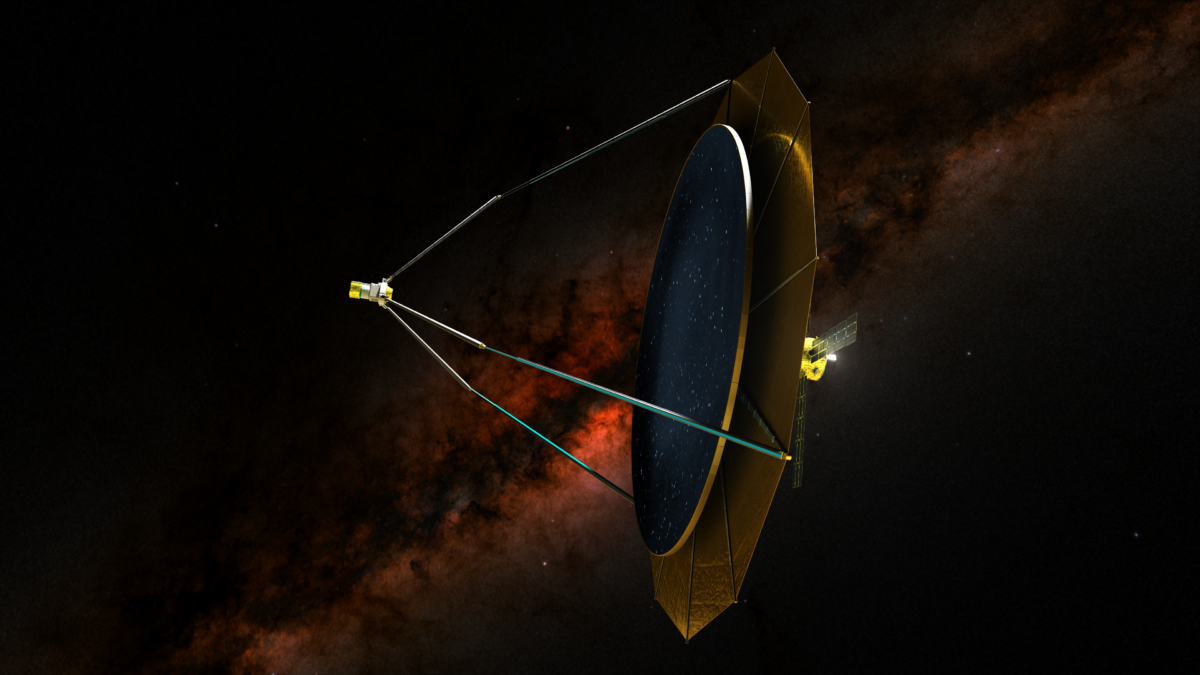
Artist's concept of the fluidic telescope (FLUTE). Credit: Edward Balaban
Powerful space telescopes like the 6.5-meter James Webb Space Telescope (JWST) will seem like toys compared to future liquid-mirror telescopes 10 to 100 times that size. Such a dream could become a reality: NASA has just granted the so-called Fluidic Telescope (JWST)Project FLUTE) three additional years of funding to study the technology, the practicalities of the demonstration mission, and a proposed 50-meter space telescope concept.
The idea has already been tested in experiments on low-gravity parabolic flights as well as on the International Space Station (ISS), and researchers hope to build an orbital spacecraft to demonstrate a one-meter liquid mirror in the next decade or so. Previous studies have also looked at suitable liquids and architectures for such a mirror, as well as monitoring its behavior during spacecraft maneuvers and temperature variations.
The research has represented a major technological breakthrough that could lead to the creation of ever larger space telescopes. “In theory, we can create mirrors as large as we want,” he says. Ed Balabana research scientist at NASA Ames Research Center in California who leads the FLUTE project.
Liquids as mirrors
Using liquids to create telescope mirrors is not a new idea; it was suggested by Isaac Newton, who invented a reflecting telescope in 1668.
A few experimental liquid mirror telescopes have been built here on Earth, but the only one currently in operation is the International Liquid Mirror Telescope (ILMT) in northern India, which uses reflections from a 4-meter-wide (13-foot) rotating reservoir of mercury. The liquid metal forms a concave mirror as it spins. However, the telescope can only look straight up toward the zenith, or the mercury would overflow from the rotating container.
The Earth's rotation also creates a Coriolis force that would perturb the liquid mirror if it ever grew larger than about 8 meters in diameter, Balaban explains. AstronomyThe solution to this limit, therefore, is to build a liquid mirror telescope in space.
Solution in space
But there are other challenges, too: Studies by Balaban and his colleagues have found that a liquid mirror would not form the same stable concave surface in space without a constant acceleration, such as gravity or an electromagnetic force. But when that proved unfeasible, the team turned to the results of previous experiments on the ISS, which revealed that in the microgravity of Earth orbit, liquids form perfect spheres through surface tension. When added to a ring-shaped frame in the right amount, the liquids take on a perfectly curved shape, like that needed for a telescopic mirror.
One of the next steps will be to determine what fluid to use.
Balaban says the team considered mercury, gallium alloys, and liquid salts impregnated with reflective nanoparticles of gold or silver. Unfortunately, both mercury and gallium proved unsuitable. The researchers now hope to use a liquid salt that will not freeze or boil in space and will only have a superficial layer of reflective nanoparticles on its surface.
Balaban says a fluidic telescope will work “as long as we have a support frame large enough for the mirror and enough fluid.”
The future of telescopes
The main hurdles remain the practicalities and costs of producing such a large instrument, and an orbiting fluidic telescope is still at least a decade away, Balaban says.
But once the technology is developed, such a telescope could reveal even more of the hidden universe than JWST, including close-up views of exoplanets, the faintest stars, and the oldest galaxies. For example, a 200-meter-wide fluidic space telescope would have a resolution more than 1,000 times greater than JWST.
Liquid mirrors can also repair themselves after disturbances such as micrometeorite impacts (JWST has already reported more than 20 such impacts).
FLUTE is not the only project studying the feasibility of a liquid mirror. Large-scale telescope (ULT)) proposes placing a 100-meter rotating liquid-mirror telescope on the Moon. The Moon's low gravity means that liquid-mirror telescopes installed there could be larger than ground-based analogues.
Telescopes on the Moon also have the advantage of having no atmosphere to peer through. And while the ULT would only be pointed at the zenith, like the ILMT, the lack of a complex mount means it could remain useful for more than a decade, says an astronomer at the University of Texas at Austin. Volker Brommone of the defenders of ULT.
Bromm says liquid mirror telescope technology will be vital beyond the next generation of ground-based telescopes. extremely large telescopesELTs are being built, which currently include the The European Space Agency's Extremely Large Telescope and the Giant Magellan Telescope.
“ELTs will have ‘maxed out’ conventional solid mirror technology… (so) the liquid mirror design paradigm will take center stage,” Bromm says.
Bromm says a 100-meter ULT could be operating on the Moon by mid-century, around the same time the 50-meter FLUTE concept could get off the ground. “FLUTE is … decades away from becoming a reality,” Bromm says. “But FLUTE serves as an important first mover, to help bridge the gap between ELTs and ULT.”